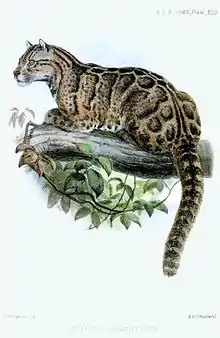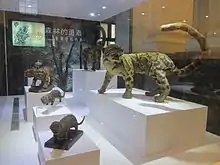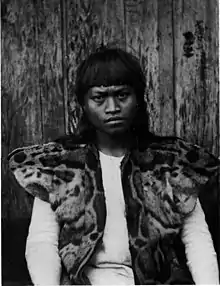Formosan clouded leopard
The Formosan clouded leopard was a clouded leopard (Neofelis nebulosa) population that was endemic to Taiwan.[2] Camera trapping studies carried out in several protected areas in Taiwan between 1997 and 2012 did not record any clouded leopard.[3][4] The population is listed as extinct on the IUCN Red List.[5]
| Formosan clouded leopard | |
|---|---|
 | |
| Drawing of a Formosan clouded leopard published in 1862[1] | |
| Scientific classification | |
| Kingdom: | Animalia |
| Phylum: | Chordata |
| Class: | Mammalia |
| Order: | Carnivora |
| Suborder: | Feliformia |
| Family: | Felidae |
| Subfamily: | Pantherinae |
| Genus: | Neofelis |
| Species: | †N. nebulosa |
| Binomial name | |
| †Neofelis nebulosa (Griffith, 1821) | |
| Synonyms | |
|
N. n. brachyurus | |
Taxonomy
Felis nebulosa was the scientific name proposed by Edward Griffith in 1821 who first described a skin of a clouded leopard that was brought alive from Canton Province in China to the menagerie at Exeter Exchange in London.[6] Leopardus brachyurus was proposed by Robert Swinhoe in 1862 who described a skin of a clouded leopard from Formosa.[1]
It was later considered the clouded leopard subspecies Neofelis nebulosa brachyurus. However, genetic analysis of hair samples of Neofelis specimens revealed that the Formosan clouded leopard is not distinct from the mainland clouded leopard.[7][8] The Formosan clouded leopard is therefore currently not recognised as a distinct clouded leopard subspecies.[2]
Characteristics

It was first described in 1862 on the basis of a traded skin with an incomplete tail. Its fur colour is pale to tawny, and it has large cloud-like markings on the shoulders and flanks with a few spots within the clouds.[1][9] In his first description of four Formosan clouded leopard skins, Swinhoe noted the shortness of its tail, which is about one-half the length of clouded leopard specimens from the Himalayas.[1] It was Taiwan's second-largest carnivore, after the Formosan black bear.[3]
Last efforts

An interview survey conducted in 1986 among 70 Taiwanese aboriginal hunters revealed that they sighted a Formosan clouded leopard in the Tawu Mountain area in 1983 for the last time.[10] In 1989, the skin of a young individual was found in the Taroko National Park area, which is the last confirmed record.[11] Pugmarks reported in the 1990s near Yushan National Park were suspected, but not confirmed to be of a clouded leopard.[12][13]
It has been assumed that clouded leopards retreated into the Yushan Range and Tawu Mountain after extensive logging of natural habitat. Today, the Tawu Mountain Nature Reserve is a protected area encompassing about 480 km2 (190 sq mi). It harbours the largest remaining primary forest in southern Taiwan and comprises tropical and subtropical rainforest as well as temperate broadleaf and mixed forest and temperate coniferous forest.[3]
Between 1997 and 2012, camera trapping surveys were conducted in more than 1,450 sites in potentially suitable habitats across Taiwan, from the seashore to an elevation of 3,796 m (12,454 ft), in fragmented lowlands and inside protected areas.[4] This survey also included 13,000 camera trap nights between 2000 and 2004 in Tawu Mountain Nature Reserve and the adjacent Twin Ghost Lake Important Wildlife Area.[3] During a nationwide survey effort of 128,349 camera trap days, 12 potential prey species were recorded, including the sambar (Rusa unicolor), the Formosan serow (Capricornis swinhoei), Reeves's muntjac (Muntiacus reevesi), the Formosan macaque (Macaca cyclopis) Swinhoe's pheasant (Lophura swinhoii) and rodents. However, not a single clouded leopard was recorded. It is therefore considered extirpated.[4]
Alleged sightings
In the summer of 2018, two different groups of rangers allegedly sighted a clouded leopard in Taitung County. One group claimed to have seen an individual climbing a tree and hunting goats on a cliff. The other group contended to have observed an individual darting past a scooter on a road and climbing into a tree.[14][15]
In culture
The Rukai, Taiwanese aborigines, considered the hunting of clouded leopards a taboo.[16]
References
- Swinhoe, R. (1862). "On the Mammals of the Island of Formosa". Proceedings of the Zoological Society of London: 348–365.
- Kitchener, A. C.; Breitenmoser-Würsten, C.; Eizirik, E.; Gentry, A.; Werdelin, L.; Wilting, A.; Yamaguchi, N.; Abramov, A. V.; Christiansen, P.; Driscoll, C.; Duckworth, J. W.; Johnson, W.; Luo, S.-J.; Meijaard, E.; O’Donoghue, P.; Sanderson, J.; Seymour, K.; Bruford, M.; Groves, C.; Hoffmann, M.; Nowell, K.; Timmons, Z. & Tobe, S. (2017). "A revised taxonomy of the Felidae: The final report of the Cat Classification Task Force of the IUCN Cat Specialist Group" (PDF). Cat News (Special Issue 11): 64.
- Chiang, P.-J. (2007). Ecology and Conservation of the Formosan clouded leopard, its prey, and other sympatric carnivores in southern Taiwan (PDF) (PhD). Blacksburg, Virginia: Virginia Polytechnic Institute and State University.
- Chiang, P. J.; Pei, K. J. C.; Vaughan, M. R.; Li, C. F.; Chen, M. T.; Liu, J. N.; Lin, C. Y.; Lin, L. K.; Lai, Y. C. (2015). "Is the clouded leopard Neofelis nebulosa extinct in Taiwan, and could it be reintroduced? An assessment of prey and habitat". Oryx. 49 (2): 261–269. doi:10.1017/S003060531300063X.
- Grassman, L.; Lynam, A.; Mohamad, S.; Duckworth, J.W.; Borah, J.; Wilcox, D.; Ghimirey, Y.; Reza, A.; Rahman, H. (2016). "Neofelis nebulosa". IUCN Red List of Threatened Species. 2016: e.T14519A97215090.
- Griffith, E. (1821). "The Chinese, or tortoiseshell Tiger. Felis nebulosa". General and particular descriptions of the vertebrated animals arranged comfortably to the modern discoveries and improvements in zoology. London: Baldwin, Cradock & Joy. p. 37.
- Buckley-Beason, V. A.; Johnson, W. E.; Nash, W. G.; Stanyon, R.; Menninger, J. C.; Driscoll, C. A.; Howard, J.; Bush, M.; Page, J. E.; Roelke, M. E.; Stone, G.; Martelli, P. P.; Wen, C.; Ling, L.; Duraisingam, R. K.; Lam, P. V. & O'Brien, S. J. (2006). "Molecular evidence for species-level distinctions in clouded leopards". Current Biology. 16 (23): 2371–2376. doi:10.1016/j.cub.2006.08.066. PMC 5618441. PMID 17141620.
- Kitchener, A. C.; Beaumont, M. A. & Richardson, D. (2006). "Geographical variation in the clouded leopard, Neofelis nebulosa, reveals two species". Current Biology. 16 (23): 2377–2383. doi:10.1016/j.cub.2006.10.066. PMID 17141621. S2CID 6838593.
- Kitchener, A. C.; Beaumont, M. A.; Richardson, D. (2006). "Geographical Variation in the Clouded Leopard, Neofelis nebulosa, Reveals Two Species". Current Biology. 16 (23): 2377–2383. doi:10.1016/j.cub.2006.10.066. PMID 17141621. S2CID 6838593.
- Rabinowitz, A. (1988). "The clouded leopard in Taiwan". Oryx. 22 (1): 46–47. doi:10.1017/S003060530002740X.
- Anonymous (1996). "The mystery of the Formosan clouded leopard". Cat News (24): 16.
- Lue, K. Y.; Chang, W. S.; Hwa, B. Z. (1992). The Faunal Investigation on Yu-Li Wildlife Nature Reserve. Report 79-02. Taipei: Taiwan Forest Bureau Conservation and Research.
- Wang, Y.; Chen, Y.; Lai, C. (1996). Wildlife population study and monitor at Nan-Tzy-Shian River watershed area. Taipei: Conservation and Planning Administration, Ministry of Interior, Taiwan.
- Everington, K. (2019). "'Extinct' Formosan clouded leopard spotted in E. Taiwan". Taiwan News.
- Hoffner, E. (2019). "Taiwan: Extinct leopard subspecies allegedly seen by rangers". Mongabay. Retrieved 2019-03-04.
- Pei, K. (1999). Hunting System of the Rukai Tribe in Taiwan, Republic of China. Proceedings of the International Union of Game Biologists XXIV Congress, Thessaloniki, Greece.
External links
| Wikimedia Commons has media related to Neofelis nebulosa brachyura. |
| Wikispecies has information related to Neofelis nebulosa. |
